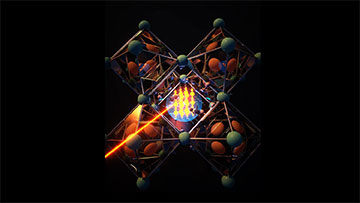
Caption: Researchers at North Carolina State University, USA, have observed a macroscopic quantum state known as superfluorescence in a hybrid perovskite at room temperature, thanks to what they argue are the shock-absorbing qualities of polaron quasiparticles. [Image: Ella Maru Studio]
Being able to maintain and manipulate macroscopic quantum states is central to the development of quantum information technology. But doing so generally requires operating at cryogenic temperatures to minimize the thermal fluctuations that would otherwise destroy the states’ coherence.
Now researchers in the United States have shown it is possible to create one such macroscopic state—superfluorescence—in a hybrid perovskite semiconductor at room temperature. They put the eye-catching result down to what they describe as naturally-occurring quantum “shock absorbers”—quasiparticles known as polarons that shield excited electrons from all lattice vibrations bar their own (Nat. Photon., doi: 10.1038/s41566-022-00974-4).
Suppressing thermal fluctuations
Superfluorescence occurs when electronic dipoles are excited by a laser and their phases spontaneously align, creating a collective coherent state. That state has a much stronger dipole moment than would be possible in the absence of coherence, yielding a short, extremely intense photon pulse when the electrons drop back down to their ground state.
This phenomenon can’t take place in most solids because the thermal fluctuations of a crystal’s lattice wipe out coherence before the dipoles can fully synchronize. Suppressing these fluctuations has generally called for experiments to be carried out at cryogenic temperatures or with powerful magnetic fields. But last year, Kenan Gundogdu and colleagues at North Carolina State University, USA, showed that the hybrid perovskite methylammonium lead iodide exhibits superfluorescence at temperatures of at least 78 K.
The same group has now observed the phenomenon in another perovskite—quasi-two-dimensional phenethylammonium cesium lead bromide—but this time at far higher temperatures. The researchers did so by firing 100-fs blue laser pulses at the material at 78 K and 300 K, and in both cases observed a sharp peak in the photoluminescence spectrum at 2.36 eV when directing a certain fluence, or minimum energy per unit area, at the sample (4.0 μJ/cm2 for 78 K and 25.0 μJ/cm2 for 300 K).
To confirm that this peak was indeed generated by superfluorescence, the researchers carried out a range of additional measurements, including tracking of the sample’s emission over time. Firing pulses at below the energy-per-unit-area threshold, they saw that the emission rose to a maximum after a few picoseconds and then dropped off gradually. At significantly above the threshold, in contrast, the initial rise was followed by a much higher peak. This, they say, is characteristic of superfluorescence—in contrast with amplified spontaneous emission, which does not require macroscopic coherence.
Polarons as springs
To account for the occurrence of this phenomenon at the unusually high temperature of 300 K, Gundogdu and colleagues turned to polarons. These are the combined effect of an electron and the deformation the electron creates as it moves through a crystal lattice and displaces atoms from their resting places. According to the researchers, these entities act like a spring that isolates a system from external vibrations.
As the researchers explain, an excited electron can be considered a quantum oscillator made from the superposition of the first two resonant states within a particle-in-a-box’s potential well. If the walls of the box vibrate randomly, then the potential changes and the states become out of phase with one another, losing their coherence. In a solid crystal, the walls are the atoms, so if they fluctuate thermally the electrons become decoherent.
The idea is that the box becomes isolated from the vibrations thanks to it being separated from the outside world by a spring. As in classical physics, that spring vibrates only weakly in response to noise above its resonant frequency. If the spring is large enough, its frequency will be lower than that of any external noise source and likely block those vibrations.
The existence of large polarons in a perovskite would have the same effect—isolating electronic oscillators from higher-frequency thermal vibrations. Since it is these random vibrations, or stochastic phonons, that cause electrons to lose phase with one another, their blocking allows the formation of a macroscopic state that radiates energy in a burst of superfluorescence.
Perovskites and beyond
The researchers argue that the wide variety of hybrid lead-halide perovskites makes these materials ideal for studying the role of polarons in quantum shock absorption, adding that polarons’ stability and isolation frequency require further probing. But they say that any material exhibiting polaron-like behavior could be investigated to this end, such as inorganic perovskites or two-dimensional materials more generally. They reckon that understanding the shock absorption process in these varied systems might lead to discoveries of other quantum coherent phenomena at “practical temperatures,” including high-temperature superconductivity.
